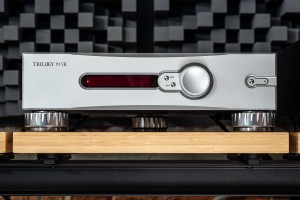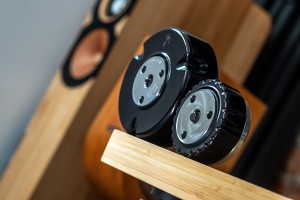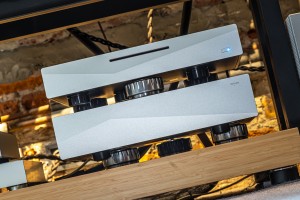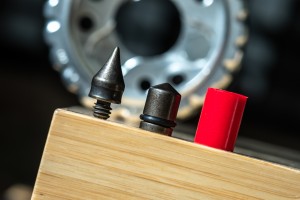The company Carbide Audio is known for Base footers which pack elastomers and ball bearings inside their very large bodies. Now that lineup features two other noticeably smaller anti-vibration products. One of them named Carbide Base Micro is this review’s subject. Enjoy!
Landmines. Downsized.
In September 2023 in this review I wrote how some audio manufacturers focus on reworking their rosters, while others prefer perfecting just one design. Back then the company Carbide Audio pursued the latter path. Fast forward less than a year and this is no longer the case. Now this portfolio accommodates three products and several upgrade options for each. Prior to tackling the new arrivals let’s first briefly recap the company’s track record. In December 2021 I sampled the original Carbide Base here. Then two springs later Srajan published the story about the Diamond version of this product and so did I. We can’t know how useful all these reviews were to Carbide Audio’s founder Jeffrey Jenkins. The subsequent effects of such efforts are difficult to measure after all. These days however his distributor/dealer list is rather busy, so I like to think that Srajan’s and my findings partially contributed. Then again, Carbide Bases are highly effective nicely made internally elaborate accessories which don’t break the bank and tick all the relevant checkboxes. Their maker also doesn’t shy away from measurements which explain why they work the way they work. That builds confidence among shoppers. Add it all up and Jeffrey Jenkins deserves success for just the right reasons. They say that in Texas everything is bigger. Carbide Bases make that point by being the largest among their kind I’ve seen yet. If you consider these anti-vibration landmines too far out in this regard, their substantial round milled bodies are necessary to keep the critical internal viscoelastic rings in place. To remain effective, these tall thin rubbery inserts have to compress without bulging outward. Their sizeable enclosures enable one action and prevent the other. Form follows function, just disguised as an unusually large object that you don’t want to step on. Somewhere during my experiments with Carbide’s best efforts I wondered about their maker’s next steps. At that time he already had two brand new products in their late development stage. In March 2024 Srajan got his hands and ears on that lot’s first model named Nano. This smallest Carbide affair is based on just one ball bearing without any viscoelastic support at all. The second newcomer baptized Base Micro nicely fills the sizing gap between the company’s tiniest and largest footers, but there’s far more to it than just that. Long story short, a squad of six Base Micros with some extras for them was recently sent my way.
They say that in Texas everything is bigger. Carbide Bases make that point by being the largest among their kind I’ve seen yet. If you consider these anti-vibration landmines too far out in this regard, their substantial round milled bodies are necessary to keep the critical internal viscoelastic rings in place. To remain effective, these tall thin rubbery inserts have to compress without bulging outward. Their sizeable enclosures enable one action and prevent the other. Form follows function, just disguised as an unusually large object that you don’t want to step on. Somewhere during my experiments with Carbide’s best efforts I wondered about their maker’s next steps. At that time he already had two brand new products in their late development stage. In March 2024 Srajan got his hands and ears on that lot’s first model named Nano. This smallest Carbide affair is based on just one ball bearing without any viscoelastic support at all. The second newcomer baptized Base Micro nicely fills the sizing gap between the company’s tiniest and largest footers, but there’s far more to it than just that. Long story short, a squad of six Base Micros with some extras for them was recently sent my way. Carbide Audio Bases are patent pending hybrid designs, which combine soft viscoelastic inserts named ViscoRings and rigid ceramic ball bearings rolling in-between hardened and polished races. The latter decoupling method is the horizontal isolation provider, so not anything new per se. The former is built upon a rubbery component formed in a very low shape factor, so that it can behave like a spring with a low spring rate and low natural resonance frequency, which in turn provides vertical isolation particularly useful for the bass. Although today’s Base Micro is fundamentally the same soft-hard decoupler type, it’s noticeably more compact due to its infusion with three small ViscoRings instead of one large insert. Less viscoelastic material in this new footer translates into its lesser damping capacity in comparison to the larger sibling, but they’re still close on this front. Three blue/black/red tiny viscoelastic cylinders installed in each Base Micro support loads up to 3.4/6.8/19.3kg respectively and work best near their upper weight limit. Here simple math applies. A 10kg DAC will be happy atop three Base Micros with blue inserts, while their black counterparts will do the trick i.e. for an amp that shows twice as much on the scale. Weigh your hardware and proceed accordingly. That’s the clear motto.
Carbide Audio Bases are patent pending hybrid designs, which combine soft viscoelastic inserts named ViscoRings and rigid ceramic ball bearings rolling in-between hardened and polished races. The latter decoupling method is the horizontal isolation provider, so not anything new per se. The former is built upon a rubbery component formed in a very low shape factor, so that it can behave like a spring with a low spring rate and low natural resonance frequency, which in turn provides vertical isolation particularly useful for the bass. Although today’s Base Micro is fundamentally the same soft-hard decoupler type, it’s noticeably more compact due to its infusion with three small ViscoRings instead of one large insert. Less viscoelastic material in this new footer translates into its lesser damping capacity in comparison to the larger sibling, but they’re still close on this front. Three blue/black/red tiny viscoelastic cylinders installed in each Base Micro support loads up to 3.4/6.8/19.3kg respectively and work best near their upper weight limit. Here simple math applies. A 10kg DAC will be happy atop three Base Micros with blue inserts, while their black counterparts will do the trick i.e. for an amp that shows twice as much on the scale. Weigh your hardware and proceed accordingly. That’s the clear motto.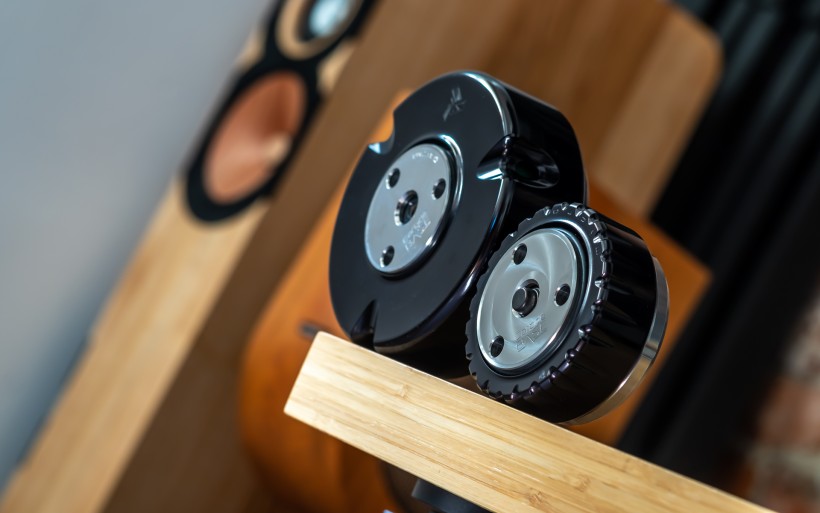 The largest Carbide Base Diamond footers feature bits machined from the manufacturer’s manganese-copper (Mn-Cu) alloy named TwinDamp. I was informed that it is among the highest-damping such materials available and ten times more efficient in this regard than pure copper. Although TwinDamp dissipates vibrations into heat just like an elastomer does, it forces these tiny movements to occur instantaneously rather than over a few milliseconds as is the case in the latter. To simplify, TwinDamp’s quicker settling time makes it a faster more reactive material, albeit not quite as efficient on damping as inherently lossy viscoelastics, so not as much in control of intense vibrations i.e. from large loudspeakers. Jeffrey informed me that TwinDamp’s lesser vertical isolation is due to its lack of mechanical compliance mandatory for isolating the out-of-phase movement. This is a very stiff and hard alloy after all, but its responsiveness still is a major asset. It also behaves similarly to the elastomers on horizontal isolation and in how it achieves damping. When a ViscoRing deflects in response to a vibration, friction between the intermolecular bonds within its rubbery body converts the vibration energy into heat. TwinDamp nets the same result via friction between the boundaries of the twin crystal segments within it. If the available color-coded ViscoRings for Base Micros don’t cover your needs, hard TwinDamp bullets (€69/3) are the fourth radically different option that elevates the supported weight limit to 158kg per puck. Most importantly, it also promises some desirable sonic perks under lighter loads. My loaner set had exclusively these rigid inserts installed. In the package there were also several red cylinders to show them as a reference and 18 optional TwinDamp spikes priced at €24 each. A single Base Micro wants three such companions, so €72 extra. If that’s too steep, stainless steel equivalents sold for €7/ea. are the alternative. Although a circular ridge machined on the Base Micro’s height-adjustable underside acts very much like a spike, Jeffrey told me that many his customers reported better sound upon arming their Base Micros with pointy cones still. He was interested in knowing what I had to say on the matter. More about that later.
The largest Carbide Base Diamond footers feature bits machined from the manufacturer’s manganese-copper (Mn-Cu) alloy named TwinDamp. I was informed that it is among the highest-damping such materials available and ten times more efficient in this regard than pure copper. Although TwinDamp dissipates vibrations into heat just like an elastomer does, it forces these tiny movements to occur instantaneously rather than over a few milliseconds as is the case in the latter. To simplify, TwinDamp’s quicker settling time makes it a faster more reactive material, albeit not quite as efficient on damping as inherently lossy viscoelastics, so not as much in control of intense vibrations i.e. from large loudspeakers. Jeffrey informed me that TwinDamp’s lesser vertical isolation is due to its lack of mechanical compliance mandatory for isolating the out-of-phase movement. This is a very stiff and hard alloy after all, but its responsiveness still is a major asset. It also behaves similarly to the elastomers on horizontal isolation and in how it achieves damping. When a ViscoRing deflects in response to a vibration, friction between the intermolecular bonds within its rubbery body converts the vibration energy into heat. TwinDamp nets the same result via friction between the boundaries of the twin crystal segments within it. If the available color-coded ViscoRings for Base Micros don’t cover your needs, hard TwinDamp bullets (€69/3) are the fourth radically different option that elevates the supported weight limit to 158kg per puck. Most importantly, it also promises some desirable sonic perks under lighter loads. My loaner set had exclusively these rigid inserts installed. In the package there were also several red cylinders to show them as a reference and 18 optional TwinDamp spikes priced at €24 each. A single Base Micro wants three such companions, so €72 extra. If that’s too steep, stainless steel equivalents sold for €7/ea. are the alternative. Although a circular ridge machined on the Base Micro’s height-adjustable underside acts very much like a spike, Jeffrey told me that many his customers reported better sound upon arming their Base Micros with pointy cones still. He was interested in knowing what I had to say on the matter. More about that later. Carbide Audio Base Micro looks simple at first glance, but internally is a complex multi-layered effort no less. The threaded bottom plate rotates to regulate the footer’s height. It has to come off to reveal openings for spikes, but the second threading in its middle accepts the large Carbide Base’s wider thicker counterpart that says hello to spikes as is. Although it wasn’t necessary for me to go this route, I’ve found it thoughtful that parts from Jeffrey’s different products are 100% compatible. Moving on, the Base Micro’s second lowest stainless steel deck, which is the foundation of the entire structure, features hardened polished steel races for three ceramic balls rolling in them. It hides inside a large round CNC-milled aluminium enclosure that packs the upper ball races and compartments to install either ViscoRings or TwinDamp inserts. Small openings in these chambers help with mapping whether bullets inside them have their pointy ends facing upwards. Carbide Audio Base Micro in its most affordable form incorporates two independent isolation stages plus one extra vibration attenuation method if we count in the optional spikes. That’s already generous, but things get far spicier from here. The upper piece installed in the middle of the aluminium chassis contacts the three replaceable inserts of your choice and also determines the Base Micro’s version. My loaners had that element in its standard solid steel form. It can easily upgrade either to the Sapphire (€129/ea.) or Diamond (€329/ea.) tiers which add yet another ball bearing isolation layer. These optional fancy ingredients share the same two-piece steel body and zirconia spheres, while the curved races for them make all the difference. The Sapphire insert has these critical small parts coated in a Diamond-Like Carbon (DLC) material blended with a special metal alloy, which has a surface hardness in the ballpark of sapphire, hence the name. In the Diamond league they’re machined out of even harder solid ceramic coated in amorphous (PVD) diamond that’s about 3x more slippery than the DLC coating and 10x more than polished steel. The best insert for Base Micros also has TwinDamp pads above the top raceways, which the Sapphire equivalent doesn’t have. Sapphire and Diamond inserts meant for Carbide’s largest model and today’s pucks are identical thus interchangeable.
Carbide Audio Base Micro looks simple at first glance, but internally is a complex multi-layered effort no less. The threaded bottom plate rotates to regulate the footer’s height. It has to come off to reveal openings for spikes, but the second threading in its middle accepts the large Carbide Base’s wider thicker counterpart that says hello to spikes as is. Although it wasn’t necessary for me to go this route, I’ve found it thoughtful that parts from Jeffrey’s different products are 100% compatible. Moving on, the Base Micro’s second lowest stainless steel deck, which is the foundation of the entire structure, features hardened polished steel races for three ceramic balls rolling in them. It hides inside a large round CNC-milled aluminium enclosure that packs the upper ball races and compartments to install either ViscoRings or TwinDamp inserts. Small openings in these chambers help with mapping whether bullets inside them have their pointy ends facing upwards. Carbide Audio Base Micro in its most affordable form incorporates two independent isolation stages plus one extra vibration attenuation method if we count in the optional spikes. That’s already generous, but things get far spicier from here. The upper piece installed in the middle of the aluminium chassis contacts the three replaceable inserts of your choice and also determines the Base Micro’s version. My loaners had that element in its standard solid steel form. It can easily upgrade either to the Sapphire (€129/ea.) or Diamond (€329/ea.) tiers which add yet another ball bearing isolation layer. These optional fancy ingredients share the same two-piece steel body and zirconia spheres, while the curved races for them make all the difference. The Sapphire insert has these critical small parts coated in a Diamond-Like Carbon (DLC) material blended with a special metal alloy, which has a surface hardness in the ballpark of sapphire, hence the name. In the Diamond league they’re machined out of even harder solid ceramic coated in amorphous (PVD) diamond that’s about 3x more slippery than the DLC coating and 10x more than polished steel. The best insert for Base Micros also has TwinDamp pads above the top raceways, which the Sapphire equivalent doesn’t have. Sapphire and Diamond inserts meant for Carbide’s largest model and today’s pucks are identical thus interchangeable. Now let’s take a detour towards the manufacturer’s smallest and mechanically simplest Nano footer. Inside its austenitic stainless steel internally threaded body mounts the key component comprised of one large zirconia ball between two races, while the upper piece just above ends with a protruding nipple in direct contact with an audio product you put on it. This removable Nano insert in its standard form features sapphire races and steel topmost part, while the higher-tiered Nano Diamond sports PVD-coated ceramic races and the topmost section made of TwinDamp. Most importantly, the standalone Nano insert (€50/150 for Sapphire/Diamond versions respectively) is available as an upgrade for all three Base and Base Micro models. Installed in their upper decks it provides yet another isolation stage and also limits supported weight to 55kg per footer.
Now let’s take a detour towards the manufacturer’s smallest and mechanically simplest Nano footer. Inside its austenitic stainless steel internally threaded body mounts the key component comprised of one large zirconia ball between two races, while the upper piece just above ends with a protruding nipple in direct contact with an audio product you put on it. This removable Nano insert in its standard form features sapphire races and steel topmost part, while the higher-tiered Nano Diamond sports PVD-coated ceramic races and the topmost section made of TwinDamp. Most importantly, the standalone Nano insert (€50/150 for Sapphire/Diamond versions respectively) is available as an upgrade for all three Base and Base Micro models. Installed in their upper decks it provides yet another isolation stage and also limits supported weight to 55kg per footer. A standard Base Micro without any extras other than the mandatory three ViscoRings retails for €199/ea. The fully kitted out Diamond version with a Nano Diamond insert plus three of each TwinDamp spikes and TwinDamp bullets wants €790. Regular Base Micros with all the optional accessories for them are priced at €471 per puck, so roughly in the financial middle. Should you ask why Jeffrey didn’t go full hog with my set, he explained that the Nano Diamond upgrade is a cost-efficient alternative to the footer’s Diamond version. Their combination has the benefit of a slightly lower natural frequency thus better isolation of the lowest bass, but I was told that the difference on performance is small. Besides, at any moment I could easily transplant Diamond bits from large Carbide Bases at my disposal to today’s decouplers. Then each Base Micro would feature three independent bearing-based isolation stages plus TwinDamp spikes, bullets and top caps on vibration damping/attenuation duties.
A standard Base Micro without any extras other than the mandatory three ViscoRings retails for €199/ea. The fully kitted out Diamond version with a Nano Diamond insert plus three of each TwinDamp spikes and TwinDamp bullets wants €790. Regular Base Micros with all the optional accessories for them are priced at €471 per puck, so roughly in the financial middle. Should you ask why Jeffrey didn’t go full hog with my set, he explained that the Nano Diamond upgrade is a cost-efficient alternative to the footer’s Diamond version. Their combination has the benefit of a slightly lower natural frequency thus better isolation of the lowest bass, but I was told that the difference on performance is small. Besides, at any moment I could easily transplant Diamond bits from large Carbide Bases at my disposal to today’s decouplers. Then each Base Micro would feature three independent bearing-based isolation stages plus TwinDamp spikes, bullets and top caps on vibration damping/attenuation duties. Base Micros are ace on build quality, small form factor, willingness to accept extras, ease of use, excellent mechanics and overall premium feel. All the engineering know-how poured into these small objects is really impressive. Ditto their compatibility with upgrades shared across the manufacturer’s roster. Threaded openings on their undersides even allow for a use upside down, which was terrific news for one of my daily drivers. Micro Bases used like so can also firmly bolt to various hardware via adapters Jeffrey has in store. It seems that he thought of literally everything. Just two footers without Nano inserts are enough to support a small product (i.e. a linear PSU) without issues. Three are a must for large hardware upon installing in them these optional isolators with wobbly top pieces. Base Micros are available in silver or black and I got three of each.
Base Micros are ace on build quality, small form factor, willingness to accept extras, ease of use, excellent mechanics and overall premium feel. All the engineering know-how poured into these small objects is really impressive. Ditto their compatibility with upgrades shared across the manufacturer’s roster. Threaded openings on their undersides even allow for a use upside down, which was terrific news for one of my daily drivers. Micro Bases used like so can also firmly bolt to various hardware via adapters Jeffrey has in store. It seems that he thought of literally everything. Just two footers without Nano inserts are enough to support a small product (i.e. a linear PSU) without issues. Three are a must for large hardware upon installing in them these optional isolators with wobbly top pieces. Base Micros are available in silver or black and I got three of each. Six footers were enough to support either a pair of speakers or two electronic components at the same time. sound|kaos Vox 3afw monitors, Trilogy 915R pre and LampizatOr Pacific DAC were the obvious choices. Prior to following that plan I used all Base Micros under the Innuos Statement’s two enclosures. One, I haven’t tried any decouplers with this server/streamer for quite a while. Two, I was curious whether those mounted under each its box were as good as I remembered them. Just one back and forth sufficed to know that this wasn’t even a contest. In my system the Statement on its own short legs produced slower darker sound with thicker outlines and clearly shakier bass, as if someone took some of its happiness and liveliness away. I just hadn’t mapped this any earlier. The Base Micros contributed with the extra acceleration, radiance, imaging specificity and somewhat leaner MO particularly sensible on vocal jobs. To my ears these sonic reworks were the clear upgrades more than anything else, although on some tracks I appreciated the appeal of thicker voices more. This however didn’t factor as much as the plainly obvious change with/out Carbide footers under the Statement. I didn’t expect any meaningful sonic shifts let alone this profound, yet they were.
Six footers were enough to support either a pair of speakers or two electronic components at the same time. sound|kaos Vox 3afw monitors, Trilogy 915R pre and LampizatOr Pacific DAC were the obvious choices. Prior to following that plan I used all Base Micros under the Innuos Statement’s two enclosures. One, I haven’t tried any decouplers with this server/streamer for quite a while. Two, I was curious whether those mounted under each its box were as good as I remembered them. Just one back and forth sufficed to know that this wasn’t even a contest. In my system the Statement on its own short legs produced slower darker sound with thicker outlines and clearly shakier bass, as if someone took some of its happiness and liveliness away. I just hadn’t mapped this any earlier. The Base Micros contributed with the extra acceleration, radiance, imaging specificity and somewhat leaner MO particularly sensible on vocal jobs. To my ears these sonic reworks were the clear upgrades more than anything else, although on some tracks I appreciated the appeal of thicker voices more. This however didn’t factor as much as the plainly obvious change with/out Carbide footers under the Statement. I didn’t expect any meaningful sonic shifts let alone this profound, yet they were. Base Micros secured the first win mainly because the other standalone rival didn’t show up. With the Vox however they had to fight with their larger siblings, which proved far more difficult. Unsurprisingly some observations from the Statement carried over. The newcomer set acted like the accelerator and bandwidth normalizer. It trimmed the lowest bass, firmed up everything above and produced more articulated instrumental and vocal shapes. These sound sources now occupied a somewhat shallower space, as if it traded in some of the bubble-like intimacy for a more distant horizontally uniform spatial perspective. With the Micros the view was yet again sunnier and happier. The original Base Diamond footers had their revenge on a more expansive deeper sound field, closer more intimate vocals and the sensibly increased saturation and moisture the Micros didn’t have. The resulting organic texturally ripe vibe, beefier bass and larger imaging busy with denser, more lifelike and direct virtual frames were the reasons why Jeffrey’s larger pucks easily got my unequivocal vote. It was high time to install his TwinDamp spikes under Base Micros and track any changes in their favor, if any at all. Bingo. That move brought a fair share of the substance and color back, but bass output remained as is. That extra saturation applied mainly to the midrange, sound sources felt more focused, bass was more on point and increased smoothness registered, too.
Base Micros secured the first win mainly because the other standalone rival didn’t show up. With the Vox however they had to fight with their larger siblings, which proved far more difficult. Unsurprisingly some observations from the Statement carried over. The newcomer set acted like the accelerator and bandwidth normalizer. It trimmed the lowest bass, firmed up everything above and produced more articulated instrumental and vocal shapes. These sound sources now occupied a somewhat shallower space, as if it traded in some of the bubble-like intimacy for a more distant horizontally uniform spatial perspective. With the Micros the view was yet again sunnier and happier. The original Base Diamond footers had their revenge on a more expansive deeper sound field, closer more intimate vocals and the sensibly increased saturation and moisture the Micros didn’t have. The resulting organic texturally ripe vibe, beefier bass and larger imaging busy with denser, more lifelike and direct virtual frames were the reasons why Jeffrey’s larger pucks easily got my unequivocal vote. It was high time to install his TwinDamp spikes under Base Micros and track any changes in their favor, if any at all. Bingo. That move brought a fair share of the substance and color back, but bass output remained as is. That extra saturation applied mainly to the midrange, sound sources felt more focused, bass was more on point and increased smoothness registered, too. At this point I had a firm notion why TwinDamp spikes are popular among Carbide’s customers. The matter was far from over, though. I intended to exploit the fact that these parts are interchangeable. Base Diamond footers accept them, too. Just to not overly complicate the procedure, I installed one spike facing upward in each large puck’s topmost part, so that one rectangular Vox base sat atop three pointy TwinDamp heads. The result had my full attention. The sound instantly grew more muscular, powerful and focused, while the bass got more orderly, fierce and precise. I saw no downsides to this, only bold quality hikes. Audibly more ripped, dynamically charged, livelier, engaging and plainly fun outcome for €72 per speaker? Yes, please, cue in one ABBA song. Let’s not forget that each Base Diamond’s base is ready to accommodate… three spikes more. If I had enough of them, I’d surely investigate how double ball bearings and one large ViscoRing in-between two additional TwinDamp stages would’ve worked. I didn’t ask Jeffrey for extra spikes because until recently my experiences with them weren’t great. Now I know better, his are different. Live and learn.
At this point I had a firm notion why TwinDamp spikes are popular among Carbide’s customers. The matter was far from over, though. I intended to exploit the fact that these parts are interchangeable. Base Diamond footers accept them, too. Just to not overly complicate the procedure, I installed one spike facing upward in each large puck’s topmost part, so that one rectangular Vox base sat atop three pointy TwinDamp heads. The result had my full attention. The sound instantly grew more muscular, powerful and focused, while the bass got more orderly, fierce and precise. I saw no downsides to this, only bold quality hikes. Audibly more ripped, dynamically charged, livelier, engaging and plainly fun outcome for €72 per speaker? Yes, please, cue in one ABBA song. Let’s not forget that each Base Diamond’s base is ready to accommodate… three spikes more. If I had enough of them, I’d surely investigate how double ball bearings and one large ViscoRing in-between two additional TwinDamp stages would’ve worked. I didn’t ask Jeffrey for extra spikes because until recently my experiences with them weren’t great. Now I know better, his are different. Live and learn.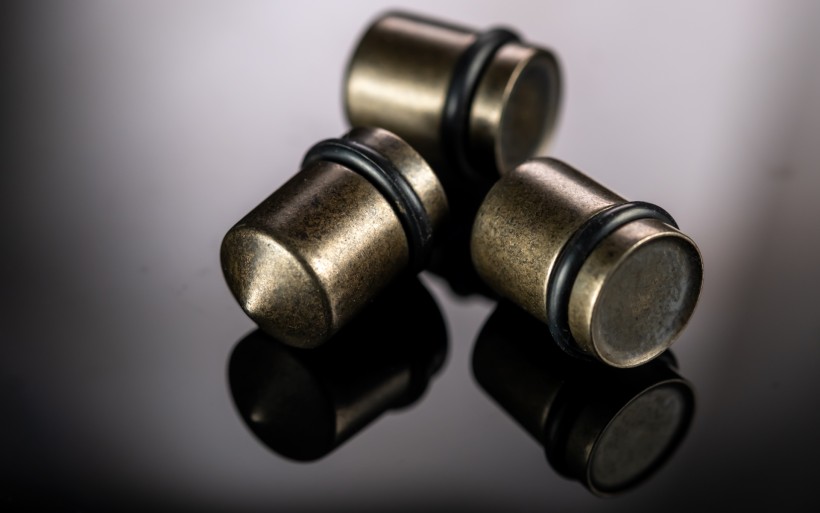 My Trilogy 915R preamp fares a happy living atop three Base Diamonds. Their more compact kin showed that this happiness can still go up, just not right away. Large footers under the British pre secured the shakiest bass and the highest vocal hydration and density. Upon replacing them with Base Micros, poof, just like that half the chunk instantly evaporated and imaging depth got a touch shallower. Meanwhile, the bass control noticeably improved, sound sources became more specific and the entire message was more upfront, direct and radiant. To my ears the two different profiles at the same commensurably high performance level just clashed. As it turned out, their best assets could largely combine. Base Micros on TwinDamp spikes provided the enjoyable middle ground that got the job done in the most powerful, energetic and focused fashion, albeit without any losses on saturation or spatial depth. That was key. Not only the newcomer on Mn-Cu legs was my easy pick, it also remained a cut above Base Diamonds with the same assistance installed in their topmost sections. The rather similar outcome was in the cards with my DAC, but the order was different. Under this machine Base Micros did clearly more than Base Diamonds. Lesser but more controlled bass output, higher clarity and somewhat shinier more pronounced upstairs were the upshots which marked the noticeably higher-tiered decoupler for the job. The use of spikes further widened the gap between contestants. With such support Base Micros parked the extra muscle tissue, higher focus and textural wetness atop all else they did. I’ve found them all in all brilliant and my top choice. Their version without spikes was the second pick and then Base Diamonds with/out them followed.
My Trilogy 915R preamp fares a happy living atop three Base Diamonds. Their more compact kin showed that this happiness can still go up, just not right away. Large footers under the British pre secured the shakiest bass and the highest vocal hydration and density. Upon replacing them with Base Micros, poof, just like that half the chunk instantly evaporated and imaging depth got a touch shallower. Meanwhile, the bass control noticeably improved, sound sources became more specific and the entire message was more upfront, direct and radiant. To my ears the two different profiles at the same commensurably high performance level just clashed. As it turned out, their best assets could largely combine. Base Micros on TwinDamp spikes provided the enjoyable middle ground that got the job done in the most powerful, energetic and focused fashion, albeit without any losses on saturation or spatial depth. That was key. Not only the newcomer on Mn-Cu legs was my easy pick, it also remained a cut above Base Diamonds with the same assistance installed in their topmost sections. The rather similar outcome was in the cards with my DAC, but the order was different. Under this machine Base Micros did clearly more than Base Diamonds. Lesser but more controlled bass output, higher clarity and somewhat shinier more pronounced upstairs were the upshots which marked the noticeably higher-tiered decoupler for the job. The use of spikes further widened the gap between contestants. With such support Base Micros parked the extra muscle tissue, higher focus and textural wetness atop all else they did. I’ve found them all in all brilliant and my top choice. Their version without spikes was the second pick and then Base Diamonds with/out them followed. One last thing worth explaining is the small snafu I had with my DAC. Its underside sports three protruding bolts which originally held in place the long-gone stock isolators made specifically for this machine. Unless one is keen to extract half of its interior, these bolts stay. To add salt to injury, their strategic location is precisely where you’d want to position aftermarket pucks to balance the enclosure and have it nice to look at. Openings in the upper sections of Base Diamond footers fully swallow these bolts and touch my DAC’s underside, which is mechanically desirable. Base Micros with their wobbly TwinDamp heads not so much. Initially I’ve tried positioning them just next to the protruding obstacles, but the visual effect was way off to my taste. Then I simply turned these footers upside down and presto, their bottom openings accepted the troublesome screws without any issues. That was a major aesthetic win. Next I armed the reversed Base Micros with TwinDamp spikes because their heads weren’t sharp enough to leave any marks on my DAC’s underbelly. Besides, I could always position each footer with the attached spikes on its base first, do a vertical 180 and then install. The main takeaway was elsewhere, though.
One last thing worth explaining is the small snafu I had with my DAC. Its underside sports three protruding bolts which originally held in place the long-gone stock isolators made specifically for this machine. Unless one is keen to extract half of its interior, these bolts stay. To add salt to injury, their strategic location is precisely where you’d want to position aftermarket pucks to balance the enclosure and have it nice to look at. Openings in the upper sections of Base Diamond footers fully swallow these bolts and touch my DAC’s underside, which is mechanically desirable. Base Micros with their wobbly TwinDamp heads not so much. Initially I’ve tried positioning them just next to the protruding obstacles, but the visual effect was way off to my taste. Then I simply turned these footers upside down and presto, their bottom openings accepted the troublesome screws without any issues. That was a major aesthetic win. Next I armed the reversed Base Micros with TwinDamp spikes because their heads weren’t sharp enough to leave any marks on my DAC’s underbelly. Besides, I could always position each footer with the attached spikes on its base first, do a vertical 180 and then install. The main takeaway was elsewhere, though.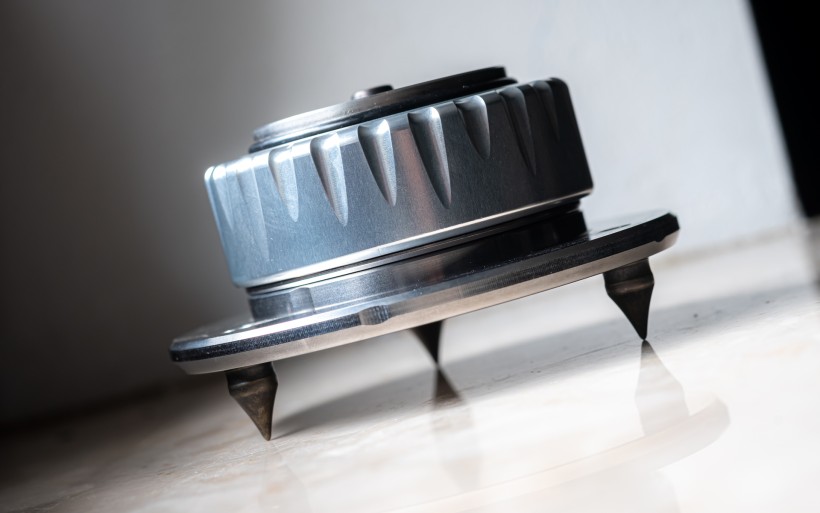 Base Micros remained equally effective no matter their orientation, which gave me something to think about. As reviewed they comprise a TwinDamp base in the form of spikes, then the first ball bearing isolation stage, then TwinDamp section followed by the second ball bearing layer with yet another TwinDamp component on top. The conducted experiments suggest that parts made out of this alloy act as potent boosters for the isolation stages between them. Jeffrey’s spikes are the natural ticket to taking the full advantage of this. That’s why I’d strongly consider these accessories if I were a shopper interested in his footers. One caveat to mention is that I haven’t sampled Carbide’s basic cones, so I don’t know how much they do in comparison to their fancier TwinDamp cousins.
Base Micros remained equally effective no matter their orientation, which gave me something to think about. As reviewed they comprise a TwinDamp base in the form of spikes, then the first ball bearing isolation stage, then TwinDamp section followed by the second ball bearing layer with yet another TwinDamp component on top. The conducted experiments suggest that parts made out of this alloy act as potent boosters for the isolation stages between them. Jeffrey’s spikes are the natural ticket to taking the full advantage of this. That’s why I’d strongly consider these accessories if I were a shopper interested in his footers. One caveat to mention is that I haven’t sampled Carbide’s basic cones, so I don’t know how much they do in comparison to their fancier TwinDamp cousins. In one of his mails Jeffrey suggested trying Base Micros under the Pacific DAC and 915R pre, and said that using them under speakers was up to me. Considering all the above, his recommendations were spot on. The man knows exactly where his latest footers work at their best and quite frankly excel. In my previous Carbide Audio review I wrote that tubed products meant for low-level signal tasks were the ideal candidates for the large Base Diamonds. Today I stand corrected as far as that lineup goes. Without spikes they’re awesome for speakers and particularly those shy on bass. On pointy TwinDamp supports they become highly useful all across the speaker gamut. Meanwhile, my DAC and pre were utmost pleased about Base Micros. I have a theory why. It seems that the quicker the vibration dissipation is, the more these tubed devices respond to and benefit from it. Since TwinDamp bullets siphon minuscule oscillations faster than ViscoRings, they effectively do more for hardware sensitive to that sort of action. After all, these inserts are the main differentiator between the two compared footer types. When and if Jeffrey decides to make TwinDamp internals for his largest pucks, that tide may turn again. For now Base Diamonds rock with speakers and Base Micros infused with their rigid bullets reign supreme with my DAC and pre. That’s why now in my system I’d incorporate Base Micros under these machines, while Base Diamonds would serve under Vox monitors and the Statement, which very nicely responds to anti-vibration upgrades as it turns out. On top of that, I’d use TwinDamp spikes wherever possible.
In one of his mails Jeffrey suggested trying Base Micros under the Pacific DAC and 915R pre, and said that using them under speakers was up to me. Considering all the above, his recommendations were spot on. The man knows exactly where his latest footers work at their best and quite frankly excel. In my previous Carbide Audio review I wrote that tubed products meant for low-level signal tasks were the ideal candidates for the large Base Diamonds. Today I stand corrected as far as that lineup goes. Without spikes they’re awesome for speakers and particularly those shy on bass. On pointy TwinDamp supports they become highly useful all across the speaker gamut. Meanwhile, my DAC and pre were utmost pleased about Base Micros. I have a theory why. It seems that the quicker the vibration dissipation is, the more these tubed devices respond to and benefit from it. Since TwinDamp bullets siphon minuscule oscillations faster than ViscoRings, they effectively do more for hardware sensitive to that sort of action. After all, these inserts are the main differentiator between the two compared footer types. When and if Jeffrey decides to make TwinDamp internals for his largest pucks, that tide may turn again. For now Base Diamonds rock with speakers and Base Micros infused with their rigid bullets reign supreme with my DAC and pre. That’s why now in my system I’d incorporate Base Micros under these machines, while Base Diamonds would serve under Vox monitors and the Statement, which very nicely responds to anti-vibration upgrades as it turns out. On top of that, I’d use TwinDamp spikes wherever possible.
The size of Carbide Bases and Base Micros suggests that they’re the manufacturer’s top and mid-tiered specimens respectively. They’re not. These are equals where it matters, just applicable under different hardware to maximize their potency. Now you know where each works best, so pick accordingly. Personally I’m chuffed with Base Micros. In the standard/maxed out version they remain respectively €100/50 below Jeffrey’s largest footers, which I think is accurate and fair considering their visual, behavioral and mechanical excellence.
Associated Equipment:
- Amplifier: Trilogy 995R, FirstWatt F7, Enleum AMP-23R
- DAC: LampizatOr Pacific (KR Audio T-100 / Living Voice 300B + KR Audio 5U4G Ltd. Ed.)
- Speakers: Boenicke Audio W11 SE+, sound|kaos Vox 3afw
- Transport: Innuos Statement, fidata HFAS1-S10U
- Preamplifier: Trilogy 915R, Thöress DFP
- Speaker cables: Boenicke Audio S3, LessLoss C-MARC
- Headphones: HifiMan Susvara
- Speaker signal conditioning: LessLoss Firewall for Loudspeakers, Boenicke ComDev
- Anti-vibration conditioning: 12x Carbide Audio Carbide Base (under DAC, preamp and speakers)
- Interconnects: LessLoss Entropic Process C-MARC, Boenicke Audio IC3 CG
- Power components: Gigawatt PC-3 SE EVO+/LC-3 EVO, LessLoss C-MARC, LessLoss Entropic Process C-MARC, Boenicke Audio Power Gate, ISOL-8 Prometheus
- USB components: iFi audio Mercury3.0
- Rack: Franc Audio Accesories Wood Block Rack 1+3
- Network: Fidelizer EtherStream, Linksys WRT160N
- Music: NativeDSD
Retail prices of reviewed components in EU (excl. VAT):
- Carbide Base Micro as reviewed: €471/ea.
- Carbide Base Micro (standard/Sapphire/Diamond): €199/299/499/ea.
- Nano insert (Sapphire/Diamond): €50/150/ea.
- TwinDamp bullets: €69/3
- TwinDamp spikes: €24/ea.
- Stainless steel spikes: €7/ea.
- Additional Micro ViscoRings: €19/3
Manufacturer: Carbide Audio














